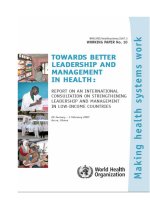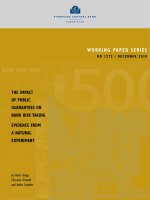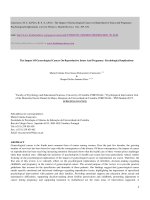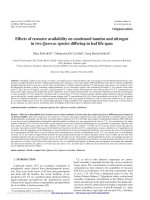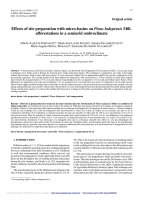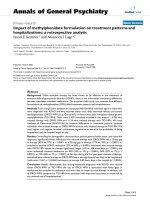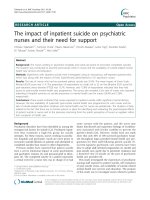THE IMPACT OF CULTURAL EVENTS ON THE CINEMA AND TOURISM IN A COMMUNITY, BUSAN pot
Bạn đang xem bản rút gọn của tài liệu. Xem và tải ngay bản đầy đủ của tài liệu tại đây (427.03 KB, 83 trang )
i
The Graduate College
University of Wisconsin-Stout
Menomonie, Wisconsin 54751
ABSTRACT
Kwon Hyun-Jin
(writer) (Last Name) (First Name)
The Impact of Cultural events on the Cinema and Tourism in a Community, Busan:
Busan’s
(Title)
alternative industry to the cinema and tourism industry after the Pusan International Film
Festival
Hospitality and Tourism Teresa Schulz August 2002 75
(Graduate Major) (Research Advisor) (Month/Year) (No. of pages)
Publication Manual of the American Psychological Association
(Name of Style Manual Used in this Study)
An event is the most exciting and fastest growing industry related to leisure.
Events can be viewed as part of the new wave of alternative tourism. This is the reason
that tourism organizations in many countries actively promote events.
An event induces tourists to participate. It makes them stay longer in the area which has
held the event. An event generates jobs for the residents. The residents would need to
develop an infrastructure to provide the many needed facilities.
This study researched the economic impact of the Pusan International Film
Festival (PIFF) on the tourism and cinema industry in Busan, South Korea. The festival
was developed with attractive characteristics as a cultural event. The finding of this
ii
study supports the positive economic impact, development of the cinema and tourism
industries, and the attitude of residents before and after PIFF in Busan.
Key words: event, special event, festival, event tourism, culture, infrastructure.
Busan*, Pusan International Film Festival (PIFF)**
( */** Today Busan officially uses ‘B’ for Busan However PIFF was launched in 1996
before Busan decided their English spelling for the name. PIFF uses ‘P’ for Busan. In
this study Busan and Pusan are the same city.)
iii
ACKNOWLEDGEMENT
The researcher would like to acknowledge Assistant Professor Teresa Schulz of the
University of Wisconsin-Stout as an advisor who supported her throughout all of the time
for this study. I would also like to thank Michael Killoren in Seattle CVB. Finally, I
thank my family who always encouraged me and was with me in spirit.
iv
TABLE OF CONTENTS
Page
ABSTRACT ………………………………………………………………………… i
ACKNOWLEDGEMENTS……………………………………………………………iii
TABLE OF CONTENTS………………………………………………………………iv
LIST OF TABLES…………………………………………………………………… vii
CHAPTER ONE: INTRODUCTION
Introduction…………………………………………………………………………….1
Statement of the Problem…………………………………………………………… 3
Definition of Terms……………………………………………………………….……4
CHAPTER TWO: REVIEW OF THE LITERATURE
Event and Relative Event Area……………………………………………….……… 6
Event…………………………………………………………………….………… 6
Event and Tourism………………………………………………….……………….7
Event, Tourism and Culture………………………………………….…………… 8
Attraction of Cultural Event Tourism……………………….………………… 8
The Change of Tourists’ Choice to Cultural Tourism…….…………………… 9
Cultural Event Tourism, Industry, and Community……… ……………………… 10
Economic Impact on a Community…………………… ……………………… 10
Social/Socioeconomical Impact on a Community…… ………………………….13
Cultural event tourism Products…………………… …………………………….14
Films as Leisure……………………………………… ………………………… 16
Attraction of Film………………………………… …………………………… 16
Movie-induced Tourism………………………… ……………………………….17
Film Festival…………………………………… ……………………………… 18
La Biennale di Venezi (Venice Film Festival) ……………………………… 18
Cannes Film Festival…………………… …………………………………… 20
Conclusion of Review of Literature……………………………………………….…22
CHAPTER THREE: METHOGOLOGIES
Interview with Michael Killoren, Director of Cultural Tourism in Seattle CVB… 24
Data Collected from Cannes and Venice International Film Festival…… ……… 25
Data Collected from the Pusan International Film Festiavl and Busan Culture and
Tourism……………………………………………… …………………………….26
Data Collected from Hotels in Busan……………… ………………………………27
Limitation of the Methodology…………………… ……………………………… 28
CHAPTER FOUR: FINDINGS
Busan City………………………………………… ……………………………… 29
History of Busan……………………………….………………………………….29
Busan and Tourism…………………………….………………………………….29
v
Busan and Cinema……………………………………………………………….30
Pusan International Film Festiaval (PIFF)……………………………………………30
PIFF………………………………………… ……………………………… …30
History……………………………………………………………………… …30
PIFF Programs and Awards…………………………………………………….31
PPP Promotion………………………………………………………….………….32
Facilities……………………………………………………………….………… 32
Accommodation…………………………………………………………………32
Transportation…………………………………………………… ……………33
Statistical Data…………………………………… ……………………….…… 33
PIFF…………………………………………………………………… ………33
Pusan Promotion Plan…………………………………………………… ……34
PIFF and Tourism…………………………………………………………………… 35
The Tourism Policy of KNTO and PIFF……………………………………… …36
Visitors Arrivals……………………………………………………………………36
Tourism Products and PIFF……………………………………………………… 37
PIFF and Cinema Industry…………………………………………………………….38
Busan Film Commission………………………………………………………… 38
Busan International Film Commission Showcase (BIFCOM)…………………….40
The Ripple Effect on Movie in Busan…………………………………………… 40
The Change of Image of Busan……………………………………………………41
Attitude of Residents……………………………………………………………….….41
Bazaar…………………………………………………………………………… 41
PIFF Club………………………………………………………………………… 42
Negative Attitude………………………………………………………………… 42
CHAPTER FIVE: CONCLUSION AND RECOMMENDATIONS
Restatement of Problems…………………………………………………………… 43
Summary of Methodology…………………………………………………………….44
Discussion of Findings……………………………………………………………… 45
Objective One…………………………………………………………………… 45
Tourism in Busan before PIFF…………………………………………………45
The cinema Industry in Busan before PIFF……………………………………46
Objective Two…………………………………………………………………… 47
Economic Impact on Busan……………………………………………………47
Residents’ Attitudes in Busan…… ………………………………………… 49
Objective Three…………………………………………………………………….50
The Negative Change brought about by Tourism and Cinema……………… 50
The Positive Change brought about by Tourism and Cinema…………………51
Tourism…………………………………………………………………….51
Cinema…………………………………………………………………… 52
Recommendation for PIFF……………………………………………………………54
Recommendation for Tourism……………………………………………………… 55
Recommendation for Cinema Industry …………………………………………… 56
Recommendation for Further Study………………………………………………… 58
vi
REFERENCES………………………………………………………………………… 60
APPENDIX
A. Questions to Michael Killoren, Director of Cultural Tourism in Seattle CVB… 71
B. Letters to the Venice and Cannes Film Festivals and Tourism Offices………… 73
C. Questions for Hotels in Busan…………………………………………………… 75
vii
LIST OF TABLES
Table Page
1 Attendance Figures at the 57
th
and 58
th
Mostra…………………………………… 19
2 The Record Numbers at 55
th
in 1998 and 56
th
in 1999…………………………… 20
3 Cannes Market………………………………………………………………………21
4 Media Cover…………………………………………………………………………22
5 PIFF Programs………………………………………………………………………31
6 PIFF Awards earned…………………………………………………………… …32
7 Final Data on the Number of Films and Visitors……………………………….… 34
8 Finals data on the Amount of Films and Visitors………………………………… 34
9 Pusan Promotion Plan Data……………………………………………………… 35
10 The Tourism Budget for Promotion of Cultural Mega-events
and Cultural Tourism Festivals…………………………………………………… 36
11 Visitors Arrivals…………………………………………………………………….37
12 The Number of Produced Films…………………………………………………….40
13 The Number of Produced Short Films, Music Video, CF, and
Others Pictures: Commercial Films and Shorts Films…………………………… 41
14 Foreign Visitors for Sightseeing in Busan and Korea…………………………… 46
15 The Number of Films Produced in Busan………………………………………… 46
1
CHAPTER 1
INTRODUCTION
Events are the most exciting and fastest growing industry related to leisure,
business, and tourism. These special attractions are of limited duration and have innate
uniqueness, which distinguishes them from permanent institutions and special attractions
(Getz, 1991). Research done by the Event Solution Fact Book records that the event
industry is nearly a $400 billion annual business. Average gross income at event
companies in 2000 was $2.38 million. The percent of companies with more than $1
million in gross revenues is 40.5% overall (Event Solution, 2002). Some researches
about mega-events documented that a spill-over effect can be found in the local economy.
However, although an event may have a negative impact on a community, an event
always has been well attended because of the significant economic profit (Park, 2002).
Moreover, on the point of tourism, events can be viewed as part of the new wave of
alternative tourism (Getz, 1991). A tourism policymaker suggests that an event could be
the key point to the solution of the off-season in tourism. St. Paul in Minnesota
conquered a winter off-season by holding their Winter Festival (Chung, 1996). Business
and tourism are not only industry fields, which benefit from events, but the host cities
themselves benefit. A mega-event demands infrastructure, such as transportation,
accommodation, stadiums, and necessary construction. Public facilities improve the
quality of residents’ lives in an event host city.
The impact of an event could be estimated not only as numerical statistics but also
as an image of a community. Haider, Kotler and Rein identified the value of events in
enhancing the image of communities and in attracting tourists. They demonstrated how
places compete for investments, quality people, and tourists, all in pursuit of more livable
2
and prosperous communities (1993). Korea is one country that has used events explicitly
and systematically to shape its international image and tourism attractiveness. Hosting
the Summer Olympic Games and a world’s fair brought global media attention; whereas,
many annual events also have image enhancements as a major goal of organizers and
sponsors.
In introducing “Visit Korea 2001,” the Ministry of Culture and Tourism selected
10 major events and festivals. Among them, Pusan International Film Festival (PIFF)
gets support from both residents and tourists. This cultural event is especially supported
and promoted by the Ministry of Culture and Tourism for developing the tourism
industry in Korea. Cultural event tourism attempts to attract foreign tourists. At the
same time, there are affirmative effects in the regional society, for it offers regional
culture to residents and gives information about national and regional culture to residents.
PIFF is the largest film festival in Asia since 1996. The event simultaneously gains fame
for its commercial opportunity and its artistic and creative purpose. The aim of the
festival is to select programs ideal for the new millennium, to enhance the marketability
of the festival, and to emphasize the discovering of new Korean and Asian cinemas. The
Pusan Promotion Plan (PPP) opens during the festival. It is a free market in which
hopeful filmmakers in Asia can meet co-producers and co-executive producers from
throughout the world.
The Korea National Tourism Organization (KNTO) announced that tourism
expenditure in Busan was approximately $30,000 in 2000. This was because Busan
ranked second in the cities visited by tourists in 2000. Furthermore, the regional location,
which is close to Japan, took advantage of the Ministry of Culture and Tourism's policy
3
decision. PIFF has the advantage of financial support from the Ministry of the
Culture and Tourism. It is recognized as a cultural event of great potential by being
successfully held five times already from 1996 to 2000. The success of PIFF and PPP
directly affected the cinema industry in Busan. Busan Film Commission (BFC), which
supports filmmakers who want to make films in Busan, proves that Busan
enthusiastically promotes the cinema industry for business reasons.
The researcher conducted the data collecting for the relationship between PIFF
and its effect on Busan in the past year. In connection with this study, three interviews
and data collecting were accomplished. Findings from this research are not limited to
PIFF. Interviews and data from chapter 2 hopefully will help to understand the entire
study. The results of the research are stated throughout this study. The economic impact
of PIFF and the ripple effect of the cinema industry produced positive results in Busan.
This study shows the transition of Busan from the point of the tourism and cinema
industry: before and after the festival.
Statement of the Problems
The purpose of this study is to describe the impact of cultural events on cinema
and tourism in a community, Busan: Busan’s alternative industry to the cinema and
tourism industry after the Pusan International Film Festival (PIFF).
This study will focus on the following objectives:
1. To understand the cinema and tourism industry of Busan before PIFF
2. To understand the PIFF and its effect on a community
4
3. To determine the negative and positive changes brought about by the cinema and
tourism industries in Busan.
Definition of Terms
The definitions of Event, Special Event, and Festival might be confused without
accurate definitions of them. The problem is how can we classify these terms by using
some kind of a measure. There are many definitions of Event, Special Event, and
Festival among researchers. However, there is an eternal conception. An event includes
a special event, mega-event, and festival within itself. Special event is a kind of an event,
mega-event is a kind of an event, and festival is also a kind of an event. That is to say
that a festival could be a festival itself and simultaneously, a festival could be an event in
an inclusive conception. There are researches which mention the relationship among
them: festival is an important component of events (Mihalik & Ferguson, 1994); festival
can be (and often are) mega-events; festival is a component of mega-events; mega-event
is essentially a festival focused around a specific theme (Walle, 1996): a festival can be a
special event, but not all special events are festivals (Getz, 1991).
Event: a notable occurrence, affair, result or something special. However, in this study,
event will be used as a synonym for special event (Getz, 1991)
Special Event: Any event outside the normal range of programs and activities of the
sponsoring or managing organization. This is a one-time event, not to be repeated. To the
customer, a special event is an opportunity for a leisure, social, or cultural experience
(Getz, 1991).
5
Festival: A public, themed celebration (Getz, 1991).
Event Tourism: A contact of varying intensity, during travel, with the natural history,
human heritage, arts and philosophy that pervade tourism destinations and/or their
cultural institutions (Minister of Industry, Science and Technology, 1993).
Culture: A whole set of implicit, widely shared beliefs, traditions, values, and
expectations that characterize a particular group of people (Pizam, 1993)
Infrastructure: systems in place, which allows for the efficient functioning
of a business activity or concentration of people, example, transportation, electricity,
water, and sewage, etc,(Gartner, 2000).
6
CHAPTER 2
REVIEW OF THE LITERATURE
Event and Relative Event area
Event
Today, the event industry is a nearly $400 billion annual business (Event
Solution, 2002). As an event has grown, this huge industry has become the essential part
of the market, such as marketing, human resources, trade, public relationships, etc
(Goldblatt, 2002 ). Event sub-fields are not scientifically categorized, as there are many
linkages. However, event is divided into many sub-fields by researchers; tourism, civic
events, hallmark events, expositions, fairs and festivals, meetings and conferences,
hospitality, retail events, sports events, and social life-cycle events (Goldblatt, 2002);
mega events, hallmark events, major events (Allen, McDonnell, O’Toole, 1999). The
diversity of sub-categories shows how event industries have developed. The number of
event associations, event training courses, and event educations prove the growth of event
industries (Harris & Griffin, 1997). This is also true for mega events. Mega-events are
short-term occurrences with long-term consequences for the host city (Mossberg, L,
1997). According to the mega-event conference in Sweden (1998), a mega-event has an
immediate impact and also, importantly, long term issues and effects (Fayos-Sola, 1998).
Short-term impacts show as an economic impact, and long-term impacts show as a socio-
economic and environmental impact. Now the attention to events is due to the
tremendous economic profits to the business sector. However, an event means not only
profit to the business sector but also a body of literature, expertise and a policy for local
development. Kelly states that leisure develops inter-activity. People can identify
7
themselves in a society, others identify them in those roles and they have certain
expectations as to how they will act (1996). Events give opportunities for meeting people
in a celebrative playground. Getz suggested that basic needs which are met by festivals
can be classified into three categories: physical, interpersonal or social, and personal
(1991), although many results have shown that tourists’ motivation for events are likely
to be multiple (Crompton & McKay, 1997). Robertson and Guerrier stated how Spain
used three major international events to help remodel the national tourism products
(1998). The Government of Guam used an event named “Sandy Castle Magic Show” to
change Guam’s limited image from a rest area to a multi-eventful tourism destination
(Cho, 1999).
Events and Tourism
Events themselves do not have to attract tourists to the area to play an important
role in a tourism development (Getz, 1991). However, there is a reason why tourists need
something to do in their free time. They will be looking for attractions or events in a
tourism destination, and expect what a tourism destination offers. Events can contribute
to a perception that a place is a nice area to visit during travel. Events will heighten
visitors’ experience and make tourists’ stay longer and encourage them to spend more
time in tourism destinations (Getz, 1991). An event provides newness, freshness and
changes, which sustain local interest in a destination and enhance its appeals to visitors.
Tourist attractions and theme parks incorporate events as a key element in their
marketing programs. Getz notes that the policy needs to consider an event as a closely
related field with tourism (1991). A tourist expects events with a wide variety of tourism
attractions to animate and interpret their products (Getz, 1997).
8
An event affects expansion of the tourist season and also the off-season. Winter
sports can be the basis of seasons in northern climates, with sports competition and
winter carnivals, and alpine cultural events. Killoren said Seattle effectively uses events
when the number of tourists is reduced in the off-season (wet winter) and hotel
occupancy is low. At this time the art events are in high gear (M, Killoren, personal
communication, March 25 to April, 2002).
Event, Tourism and Culture
Attraction of cultural event tourism
A Festival is one of the sub-fields in an event. Many event assemblies for
commercial, religious, or businesses developed today’s festivals, fairs, and public events.
A festival comprises performances, arts, and crafts demonstrations, and other interaction
between the festival and participants. European Center for Traditional and Regional
Cultures (ECTARC) considered events and festivals to be one of the attractions of
cultural tourism because of these characteristics of events and festivals (Richards, 1996).
Many small towns host short-term festivals for profit, and some communities use
festivals as a boost to tourism for the off-season (Goldblatt, 2002). When the unique
attractions of communities meet tourists’ satisfaction, a festival simultaneously gets the
most effective profit from the festival itself as well as tourists. A festival gives residents
experiences of a local culture, and at the same time, gives tourists a chance to experience
different cultures between themselves and a tourism destination (University of
Minnesota, 1998). San Francisco has its “Chinese New Year Festival” in February. This
festival is a celebration for Chinese. However, San Francisco Convention Tourists
9
Bureau (CVB) advertises this festival to tourists as a local-color festival
().
The Change of Tourists’ Choice to Cultural Tourism (new trend)
In the past, natural scenery was the most attractive to tourists. By reason of the
tourists’ preference, sightseeing had the same meaning as travel (Goeldner, Mcintosh,
and Ritchie, 2000). Travel agencies would have very similar package programs for
typical tourists in the past. However, now, a tourist is changing. Today's traveler is
generally well-educated, informed, and in search of new ideas and fulfilling adventures.
Cultural tourism is travel, which includes knowledge-based experiences, exploring the
unique history and character of a place; discovering what makes an event or location
unique, and personal discovery via the arts and humanities (Cultural Tourism, 2002).
Tourists want to travel for experience, which is something special in the tourism
destination. Axel Dessau, former director of the Danish National Tourists Office, is
credited with this concept of “life-seeing tourism”(Goeldner, Mcintosh, and Ritchie,
2000). Tourists want more activities and local culture. Japanese travel agencies have
“semi-order” package programs available. Half of a schedule is developed by a travel
agency, and the other half by a schedule selected by the customer. Dakana Ichiro, a
director of the Japanese National Tourism Organization (JNTO) mentioned that this is a
travel trend in Japan, and tourism agencies can developed a semi-order to satisfy the
cultural curiosity (Yoon, 1998). World Tourism Organization (WTO) announced that the
demand for cultural and art tourism continued to increase rapidly in1985. Now about
40% of tourists participate in cultural tourism, such as heritage, arts, culture, etc,.
10
Especially, tourists involved with films, music, arts have the propensity for higher
consumerism (Worldcup Munhwa-Jinhung, 2001).
Cultural Event tourism, Industry, and Community (impact on event)
Economic Impact on a Community
Today, events have been rapidly researched in academic and industrial fields
because of their tremendous economic impact. According to research, more than 54% of
all responding event companies reported a moderate increase in 2000, and 26% reported a
significant increase over 1999 in gross revenues (Event Solution, 2002). Special events,
particularly hallmark events and mega-events, contribute to host communities’ and
countries’ economies (Ryan, 1996). The strong growth of festival and special event
sectors in Australia is the part of a general economic trend away from an industrial
products base to a more service-based economy (Allen, McDonell, and O‘Toole, 1999).
Although a community invests a lot of money in an event, they expect to earn more than
they spend. If a city has the NFL(National Football League), this city offers services
from limousines and free stadium rental, to concessions, and parking control. It costs
over $2 million, but this is not a big investment. The economic impact of the NFL is over
$100 million. Economic impact affects a community not only through a mega-event but
also a small- scale event. Even a one night concert economically impacts a community.
Michael Jackson’s Victory tour contributed to the fund from the security to souvenirs in a
community (Catherwood & Van Kirk, 1992).
Jafari stated festivals and other events can be used to meet an economic and also
community development (2000). Tribeca Film Festival was created to boost the
11
economy of New York. Actor Robert De Niro mentioned that he created the festival to
encourage new filmmakers and boost the economy of Tribeca in New York (Leader-
Telegram, 4B, May 14,2002). Events can help with a fund raising, to change a city’s
image, to expand its trade, to stimulate its economy, and help companies to market and
introduce their products (Catherwood & Van Kirk, 1992). One of the great advantages of
community festivals and many other special events are to improve independence from
capital-intensive development projects (Getz, 1991). The importance of event tourism
for less developed nations is especially clear. This is a major new source for a job in
developing nations, because of their labor intensiveness of events (Garrison, 1989).
Events contribute to income and employment through the event itself as well as hotels,
restaurants, transportation, and even small souvenir shops. An event needs many
residents as volunteers. Larry Simonson mentioned that the quality of an event depends
on how event managers educate volunteers. It shows the event involves residents as an
important role (University of Minnesota, 1989). During an event, a community can use
publishers and media as a non-pay advertisement. An event can relatively reduce their
budget for marketing by using free advertising expense. This destination-oriented
promotion can promote an interest in a community and increase tourists’ visits
(University of Minnesota, 1989).
On the other hand, there is a negative impact of an event on a community, such as
a community resistance to tourism, loss of authenticity, damage to reputation, inflated
prices, etc,. In many undeveloped countries, Trinidad and Tobago as an example, 60
percent of consumer goods supplied to the event and tourism are imported. The impact
of expenditure for leakage is usually large (Ali & Wall, 1977).
12
However, studies of economic impact have been researched often, but these are very
difficult to estimate with one formula. Economic impact does not mean just financial
costs and revenues. Profit/loss assessment and return on investment (ROI) are
approaches to deal with the financial numbers. Many methods are overlooked, such as
social, cultural, and environmental measures (Carlsen, Getz and Soutar, 2001).
Researchers need to consider recognition of intangible costs and benefits as well as
tangible costs and benefits. Intangible benefits are long-term promotional benefits,
induced developments and construction expenditures, additional trade and business
development and increased property values. Intangible economic costs are resident
exodus, interruption of normal businesses, and underutilized infrastructure (Dwyer,
Mellor, Mistilis & Mules, 2001). Cost-benefit Analysis is the closest form to a method
which estimates the true value of an event because this method includes not only profits,
income, and job creation but also social, cultural, and environmental effects
(Mehmetoglu, 2002). Furthermore, a researcher dealt with who will be included in a
category of direct expenditure. Getz suggested to mention the following points: (1) none
of the expenditure of area residents should be included, (2) only the spending of
nonresidents visitors who come to the area especially to see the event should be included,
(3) grants and sponsorship should not be included, (4) leakage associated with
expenditure must be noted (1994). Michael Killoren mentioned the economic impact is
too difficult to estimate, but an event itself absolutely adds to the economy in a
community (Personal Communication, March 25 to April 4, 2002).
13
Social/ Sociocultural Impact on a community
Some researchers included a social impact as well as a general economic impact.
On the other point of view, a positive social impact itself can induce a positive economic
impact. Successful events change the image of the region that held that event. Cities that
have held mega-events are becoming ‘products’ or ‘brands’. After the Barcelona
Olympics Games in 1992, this city was internationally more visible. In the international
ranking, Barcelona moved from 18
th
to 7
th
position as an important convention city (Park,
2002). According to the NTB (The Netherlands Board of Tourism), major events
strengthened the image of Holland, and increased tourism. Events yielded an extra 5% of
foreign visitors per year. Furthermore, they affected domestic tourism (Gessel, 2000).
Finally, a raised regional image makes other industries effective. Especially, an event
has a close relationship with tourism. The event itself increases the number of tourists.
A city uses an event as an alternative tourism (Getz, 1991). An inflow of
nonresidents/tourists during an event affects a region socially. Although researches of
event tourism deal with visitors and residents, the image of visitors as to a sociocultural
impact is mostly expressed as a destroyer or predator even though these visitors generate
a huge economic impact. Furthermore, one research described the relationship between
residents and visitors as an invasion (Matthews, 1977). On other hand, residents are
sufferers. Visitors could damage cultural facilities and affect residents’ sense of values.
In the view of visitors, cultural event tourism can affirmatively contribute to tourists’
development of a quality of life and a sturdy sense of values (Kim & Yoon, 1998).
Korean classic music academy has under consideration a harmony between conservation
of culture and popularization for diffusing Korean classical music. These factors are
14
difficult to develop together (Kim & Yoon, 1998). However, Michael Killoren
mentioned what’s good for the resident is good for the visitor. Since the cultural event
tourist is better educated and looking for authentic experiences, the more residents know
about and are aware of their treasures, the better they might keep them (March 25 to
April 4, 2002).
Cultural Event Tourism Products
Korean Tourism depends greatly on Japanese tourists. In April, 2002, 41.6% of
foreign tourists were Japanese (KNTO, 2002). The Korean National Tourism
Organization (KNTO) suggests cultural event tourism as an alternative plan to induce
European, American and Chinese tourists to visit, because their interest in cultural
tourism is relatively higher than the Japanese.
Cultural event tourism has already been proven to play an important part in
tourism. Many countries have used their cultural resources in communities, and
developed culturally characterless regions into world tourism cities (Worldcup Munwha
Jin-Hung, 2001). During two weeks in 1997, October Festival (Oktoberfest) in Munich,
Germany, the festival employees numbered 12,000, visitors 6,000,000. The 1,300,000
Munich residents and visitors consumed 5 million liters of beer, 40 thousand sausages,
and 6 thousand chickens (Worldcup Munwha Jin-Hung, 2001). Japan was called a
country of festivals because of many yearly festivals. The Japan Tourism Organization
(JNTO) collected statistics showing that the number of annual events and festivals is
8,225 (JNTO, 2002). The government helps some festivals that do not have a self-
supporting economy. Sapporo is a city famous for snow and beautiful winter scenery.
The Sapporo Snow Festival in 1997 announced that the total ripple effect of a festival is
15
$2,457,912,576 ($1=Yen 118.8). Festival visitors were 1,856,000: residents were
951,000 and nonresidents were 905,000. The purpose of the festival was to encourage
residents to attend, and for social exchanges between residents and Japanese from other
cities, and foreigners. A festival committee invited residents to join the snow festival,
prepared a recreation area and collected ideas about the snow festival’s theme. These
efforts involving residents definitely increased participation of residents (Korean Travel
Journal, July,1998). Yufuin-Machi is an example of how a city without a cultural
background can develop as a cultural festival city. In 1970, Yufuin-Machi’s economy
declined. Residents tried to find a way to increase their economy. They rented a town
hall for screening movies in 1976 and have held film conferences. A catch phrase was “a
town without cinemas, but there are films”. Now, Yuhuin-Machi has 120
accommodations that can receive 5000 persons per day. Three million tourists visit this
city per year and 1 million among them stay over 1 day (World Cup Munhwa Jin-Hung,
2002). Tanglewood has the Boston Symphony Orchestra (BSO) festival in summer. In
this season, this city is crowded with tourists from all around the world. Michelene
McClennen, department of marketing and sales in BSO, mentioned that they promote
BSO at tourism promotion markets because culture is one part of a tourism product. If a
tourism agency want to plan a tourism package involved with BSO, they offer a sale price
to an agency and tourist (Kim, 1998).
16
Film as Leisure
Attraction of Film
Cinema began as a lower-class form of entertainment. Although involvement in
other forms of leisure and recreation, especially sports, was decreased, cinema
represented a notable exception. The nickelodeons were the first wave of mass culture
and mass leisure in America. They provided cheap recreation to an industrializing
society (Kando, 1975). A movie industry has grown in the urban and with the urban
areas and with the urban masses. Some researches show moviegoers’ characteristics.
A movie-goer is generally young, urban, and well-educated in the high socioeconomic
status (Kando, 1975). According to the Canadian Arts Consumer Profile (CACP), an art
consumer who likes to go theaters, music concerts, musicals, ethnic/heritage events is
young, urban, highly educated and has discretionary income that could be spent on the
arts (Grant & Paliwoda, 1998). Although television media popularly influences the
public, the importance of a cinema is still maintained. Movies were booming as not only
leisure but also a business. The cinema industry has expanded its business rather than
declining as new media has developed. Companies invest and give their products to
filmmakers. It is called PPL (Product Placement) advertisement and PPL uses popular
advertisement methods (Cho, 1999).
Some research results show that a film is a very attractive leisure activity to city
residents. In the Jeffres and Dobos’ research, residents in metropolitan areas have
leisure time for art, culture, and entertainment: 55%(1982), 34%(1986), 55%(1988)
(Dobos & Jeffres, 1993). However, this moviegoers’ phenomenon is not only within a
17
city because movie mania in other cities or countries started to go to other cities or
countries for movies, movie studios and locations or meeting movie stars.
Movie-induced Tourism
A movie itself is an interesting topic not only to the cinema industry but also the
tourism and leisure industries because of the economic impact of films on tourism and
leisure on regions. From the industrial viewpoint, cinema and tourism have cultural,
value-added, and international industries in common (Shim, 1999). Shim suggested that
these industries can develop together and should be supported by the government, such as
financial support and protective regulations (1999). The government of France suggested
favorable conditions to Disneyland such as 50% tax reduction of construction, a
construction of TGV station and highway interchange in front of Disneyland, the
installment payment plan, and land cost discount. Finally, they induced Disneyland to
France (Cho, 1999). Disneyland Paris was the first European theme park and attendance
was 12.6 million in 1997.
Some researches have well documented the relationship between movies and
tourism (Baker and Tooke 1996; Doren and Riley 1992). A tourist has a fantasy and
anticipation to go somewhere filmed on a screen. A movie itself does not intend to
induce people to visit locations. However, major motion pictures enhanced the
awareness, appeal, and profitability of locations. These can be re-released on mediums
such as cinemas, videos, and televisions (Baker, Doren and Riley, 1998). Furthermore, a
cinema amusement park where tourists experience and watch movies is the most famous
theme park to moviegoers. ‘Universal Studios’ and ‘Disneyland-MGM’ make Orlando in
Florida more attractive. ‘Toei Uzumasa Cinema Village’ in Japan opens a cinema studio,
